|
|
Posted By Administration,
Friday 22 November 2024
|
Author: Amy Walker
EDP Sciences physics archives demonstrate enduring influence
As the year rapidly draws to a close and planning for next year’s resources begins, we are delighted to be answering queries about our multiple physics archive collections including Annales de Physique archives (1914 to 2009), The European Physical Journal - Applied Physics (EPJAP) archives (1998 to 2015) and, notably, our most substantial archive collection, the Journal de Physique archives (1872 to 1997). The latter contains 125 years of excellence - including seminal papers by Marie and Pierre Curie, Henri Becquerel and Louis de Broglie – and is still being cited frequently by modern day researchers, demonstrating the enduring influence of the science published within.
Find out more about our archives, including the most cited articles in the Journal de Physique archives collection.
Congratulations to Dr. Daniel Lincot, Awarded the 2024 Alexandre Edmond Becquerel Prize
EPJ Photovoltaics extends heartfelt congratulations to Dr. Daniel Lincot, our Honorary Editor-in-Chief, on being awarded the 2024 Alexandre Edmond Becquerel Prize. On September 23, 2024, at the 41st European Photovoltaic Solar Energy Conference and Exhibition, both Editors-in-Chief of EPJ Photovoltaics, Prof. Pere Roca i Cabarrocas and Dr. Jean-Louis Lazzari, joined in celebrating Dr. Lincot’s achievement. Together with the EDP Sciences Team, they commend Dr. Lincot for his well-deserved honor and his significant contributions to the field of solar energy.
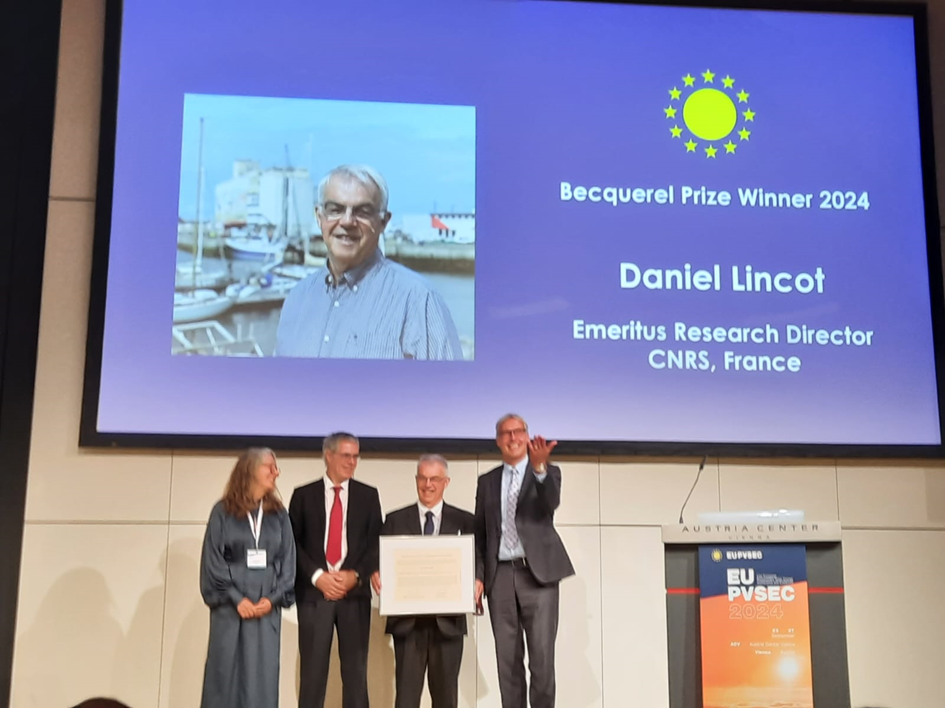
Dr Daniel Lincot is awarded the Becquerel Prize- image credit: EDP Sciences
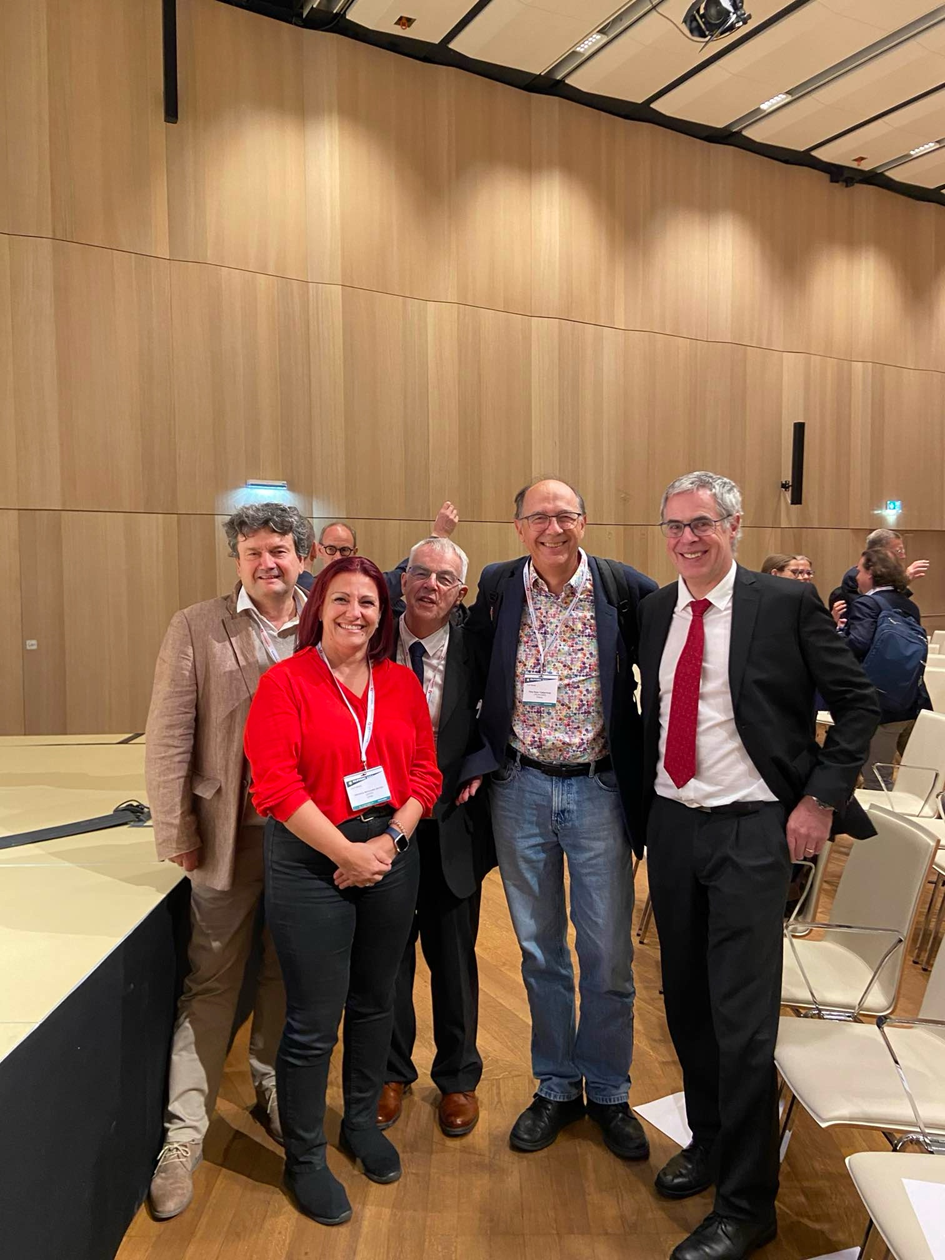
FLTR: Jean-Louis-Lazzari (EiC of EPJ Photovoltaics), Veronica Bermudez (Associate Editor of EPJ Photovoltaics),
Daniel Lincot (Honorary EiC of EPJ Photovoltaics), Pere Roca (EiC of EPJ Photovoltaics), Christophe Ballif, Chair Becquerel Committee
EPJ Web of Conferences now indexed in Scopus.
We are thrilled to announce that EPJ Web of Conferences has been accepted for indexing in one of the world’s largest abstract and citation databases of peer-reviewed literature, Scopus.
EPJ Web of Conferences is an open access publication series focused on publishing high-quality conference proceedings in the fields of Physics and related sciences. Read more about what the indexation means for the journal.
Discover recently published proceedings from EPJ Web of Conferences
Vilnius, Lithuania, August 25-30, 2024
A. Michailovas, J.I. Mackenzie, F. Pirzio and E. Cormier (Eds.)
EPJ Special Topics updates
The latest special topic in EPJ Special Topics is a 246-page technical design report presenting a detailed description of all aspects of the LUXE (Laser Und XFEL Experiment). This is published in open access, read it here.
Europhysics Letters news
In 2024, the journal EPL sponsored cash prizes again to the Best Activity Awards of the EPS Young Minds. See the article in the September issue of EPN.
EPL benefits from one of the largest collections of “transformative agreements” in the world. Many authors can therefore publish in open access in EPL free of charge, ensuring maximum dissemination of their work. Check the latest Editorial for details.
BOOK: 40 expériences de physique élémentaire issues des leçons de Marie Curie
It would be remiss of us not to mention a new book about one of our founders, Marie Curie.
This title presents lessons given by Curie to student Isabelle Chavannes, sourced directly from her notebook which was discovered in 2003. Published in French, the book reproduces the experiments taught to Chavannes using modern techniques, and includes related experiments which provide students and the science-curious with an easy way to understand essential concepts such as pressure, density, the weight of air, and more.
Discover a fun and progressive introduction to experimental physics by one of its most eminent figures, available in our Bookstore.
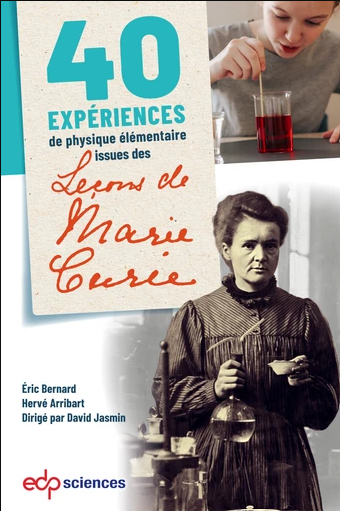
Tags:
distinction
EDP Sciences
EPS AM
EPS Associate Members
publication
Permalink
|
|
|
Posted By administration,
Monday 24 June 2024
Updated: Monday 24 June 2024
|
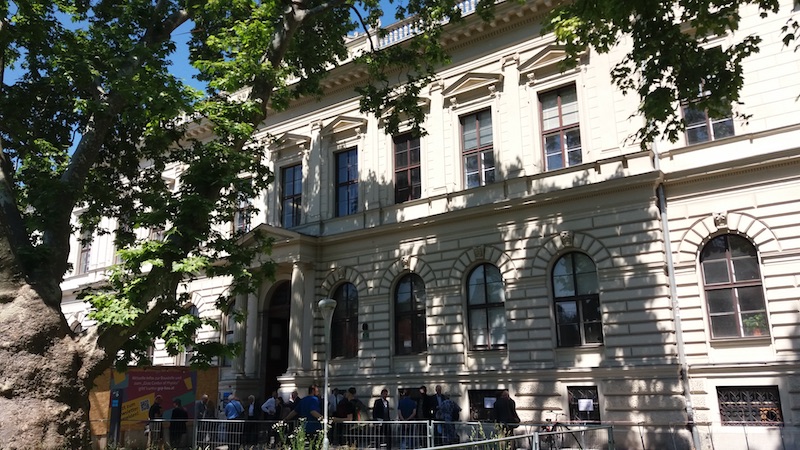
Front side of the institute of physics of the University of Graz - Image credit: Gina Gunaratnam/EPS
Authors: Sonja Draxler and Heinz Krenn
Following the decision on 16 November 2023, the building of the
Institute of Physics at the University of Graz has been honoured with
the distinction of an EPS Historic Site, an award of great importance for
achievements in physics and research. The nomination is the result of an
initiative by the First European Centre for the History of Physics
(ECHOPHYSICS, founded by Peter Maria Schuster).
In a festive
ceremony on 7th June 2024, a commemorative plaque was unveiled by Mairi
Sakellariadou, President of EPS, and Peter Riedler, Rector of Graz
University, on the facade of the physics building at Universitätsplatz
5 in Graz.
The celebration was embedded in a symposium on the historical
construction of the physics building and its leading figure Ludwig
Boltzmann. It was a special honour for us that a great-grandson of Ludwig
Boltzmann, Dieter Fasol, also participated in the symposium and gave a
lecture on “Ludwig Boltzmann, Ilse M. Fasol-Boltzmann and Artificial
Intelligence”.
The physics institute was built between 1872-1876 under the supervision of the physicist August Toepler and
was considered one of the most modern physics research centres at the
time. What was so special about this building? Sun ray corridors running
through the entire ground floor of the building enabled optical
experiments to be carried out in all rooms using heliostats. At the back
side of the building iron-free rooms for galvanometric measurements
were established, and an astronomical observatory was attached to the
building.
August Toepler himself unfortunately could not use this
modern building for his studies as he was appointed to the Royal Saxon
Polytechnic in Dresden and left Graz in 1876. Ludwig Boltzmann was
appointed as his successor. In 1876 he moved into the new institute
building in his second professorship in Graz as full professor of
general and experimental physics.
Besides Ludwig Boltzmann, a
number of other renowned physicists worked, researched and taught in
this building: August Toepler, Albert von Ettingshausen, Walther Nernst,
Svante Arrhenius, Alfred and Kurt Wegener, Viktor F. Hess, Erwin
Schrödinger, Adolf Smekal, Hans Benndorf, Paul Urban, Otto Burkard,
Wilhelm Nordberg, Günther Porod.

Floor plan from the building according to designs by August Toepler - Image credit: W. Höflechner, Archiv der Univ. Graz, post-processed by H. Krenn

Physics Lecture Hall in 1913 - Image credit: K. Rumpf, Publications of the Archive Univ. Graz, vol. 40, post-processed by H. Krenn

Unveiling the memorial plaque by EPS President Mairi Sakellariadou and Rector Peter Riedler on 7th June 2024
Image credit: K. Tzivanopoulos, Univ. Graz, Communications and Public Affairs
Tags:
distinction
EPS Historic Sites
Erwin Schrödinger
Kurt Wegener
Ludwig Boltzmann
University of Graz
Viktor F. Hess
Permalink
|
|
|
Posted By Administration,
Thursday 25 January 2024
Updated: Thursday 25 January 2024
|

The European Physical Society launched the Emmy Noether Distinction
to recognize noteworthy women physicists who have a strong connection to
Europe through their nationality or work.
Emmy Noether, with her
fundamental and revolutionary work in the abstract algebra and on
conservation laws in theoretical physics, is an exceptional historical
figure for all generations - past, present and future - of physicists.
The
laureates of the Emmy Noether Distinction are chosen for their capacity
to inspire the next generation of scientists, and especially encourage
women to pursue a career in physics. Attribution criteria therefore
focus on the candidate’s:
• research achievements
• endeavours to promote gender equality and the empowerment of women in physics
• coordination of projects and management activity
• service to the scientific community and research administration
Nominators are encouraged to address these four points in their proposal.
Commencing
2022, the EPS Emmy Noether Distinction for Women in Physics is to be
awarded once a year, to two distinguished women physicists. Namely,
the Emmy Noether Distinction will be awarded to an early- and mid–career
laureate, as well as to a more advanced candidate, as a Distinction for
her full career.
|
The selection committee, appointed by the EPS
Equal Opportunities Committee, will consider nominations of women
physicists working in Europe for the 2023 Edition of the Emmy Noether Distinction as of the nomination deadline of 31st January 2024.
|
To make a nomination, apply via this site or submit the following documents to the EPS Secretariat:
-
A
cover letter, detailing (in no more than 3 paragraphs) the motivation
for awarding the EPS Emmy Noether Distinction to the nominee;
-
The nominee’s name, institution and email
-
The nominee’s CV
-
The nominator’s name, institution, and email
-
Optional: No more than 3 support letters
 Download the distinction charter Download the distinction charter
 Read more about the EPS Emmy Noether Distinction on the EPS website Read more about the EPS Emmy Noether Distinction on the EPS website
Tags:
call
distinction
Emmy Noethe
EPS Emmy Noether Distinction
EPS EOC
EPS Equal Opportunities Committee
women in physics
Permalink
|
|
|
Posted By Administration,
Tuesday 5 December 2023
|
Author: Silvia Nicolai
The « Institut de Physique Nucléaire » (IPN) in Orsay, France, was
recently added to the list of the Historic Sites of the European
Physical Society. The laboratory, which recently became part of the
Laboratoire Irène Joliot Curie (IJCLab), received this recognition with
the following motivation: « Initiated in 1956 by Irène and Frédéric
Joliot-Curie as an extension outside Paris of the renowned « Radium
Institute » founded by Marie Curie, where in 1934 they had discovered
artificial radioactivity, and of the « Nuclear Chemistry Laboratory »
founded by Frédéric Joliot, the IPN hosted the first French big
accelerator (a synchrocyclotron) which started operating in 1958. The
creation of the IPN motivated the development of the Orsay scientific
pole. Since then the IPN, which has now become part of the IJCLab
laboratory, played and plays a pivotal role in the study of nuclear and
hadronic physics, and beyond. »
The inclusion of IPN Orsay to the
list of Historic Sites of EPS was celebrated on October 13 2023 in the
Joliot-Curie amphitheater of IJCLab, with a half-day event comprising a
ceremony and a mini-conference. The director of IJCLab, Achille Stocchi,
opened the ceremony with a welcome speech, followed by a few words by
Michel Guidal, deputy vice-president for research of the Paris-Saclay
University and former director of IPN, and by Marcella Grasso, deputy
scientific director of IN2P3 and former director of the Research
Division at IPN. Then Luc Bergé, president of EPS, presented the role
and activities of EPS, and, in particular, described the Historic Sites
program. Finally, a commemorative plaque dedicated to Irène and Frédéric
Joliot-Curie, showcasing the motivation for the recognition and the EPS
logo, was unveiled by Luc Bergé along with Hélène Joliot-Langevin,
daughter of Irène and Frédéric Joliot-Curie, and Alison Bruce, Chair of
the Nuclear Physics Division Board of EPS. Other members of the NPD
Board and the former directors of IPN also took part in the unveiling.
The
mini-conference focused on the history of IPN, from its beginnings to
nowadays. Hélène Joliot-Langevin, emeritus research director at CNRS and
former director of the Physics Division at IPN Orsay, opened the
conference presenting the origins of IPN in the historical context of
the end of World-War II. She outlined, in particular, the efforts her
parents made to reinstate France at the forefront of nuclear-physics
research in Europe, and their political investment for a pacific use of
nuclear power. Then Joel Pouthas, former director of the “Detectors and
R&D” Division at IPN and historian of physics, gave an in-depth
lecture on the history of IPN from its beginnings to recent years, a
history marked by the construction and operation of various
accelerators, made possible by several notable scientists supported by
an outstanding staff of engineers and technicians. The former director
of IPN, Sydney Galès, presented an overview of the scientific highlights
of IPN throughout its more than 60 years of history, which spanned from
low-energy nuclear physics, to hadron and high-energy physics, theory,
radiochemistry, accelerators technology, and medical and societal
applications of nuclear physics. The mini-conference was closed by a
presentation of Silvia Leoni, professor of the Università di Milano and
INFN scientist, which focused on the role of IPN in European low-energy
nuclear physics, with a particular focus on the main achievements of the
last ~15 years as well as on ongoing and future projects and
collaborations.
All the presentations, photos, and a video-recording of the event can be found on the indico page: https://indico.ijclab.in2p3.fr/event/9821/

Luc Bergé, Hélène Joliot-Langevin, and Alison Bruce unveil the commemorative plaque - image credit: Silvia Nicolai

The presidents of EPS and SFP (French Physical Society), the speakers,
the deputy director of IJCLab, the former directors of IPN, and the
members of the NPD-EPS Board pose with the commemorative plaque at the
end of the half-day event.
Tags:
awards
distinction
EPS Historic Sites
France
Frédéric Joliot-Curie
Institut de Physique Nucléaire
IPN
Irène Joliot-Curie
Orsay
Permalink
|
|
|
Posted By Gina Gunaratnam,
Tuesday 12 September 2023
Updated: Friday 15 September 2023
|
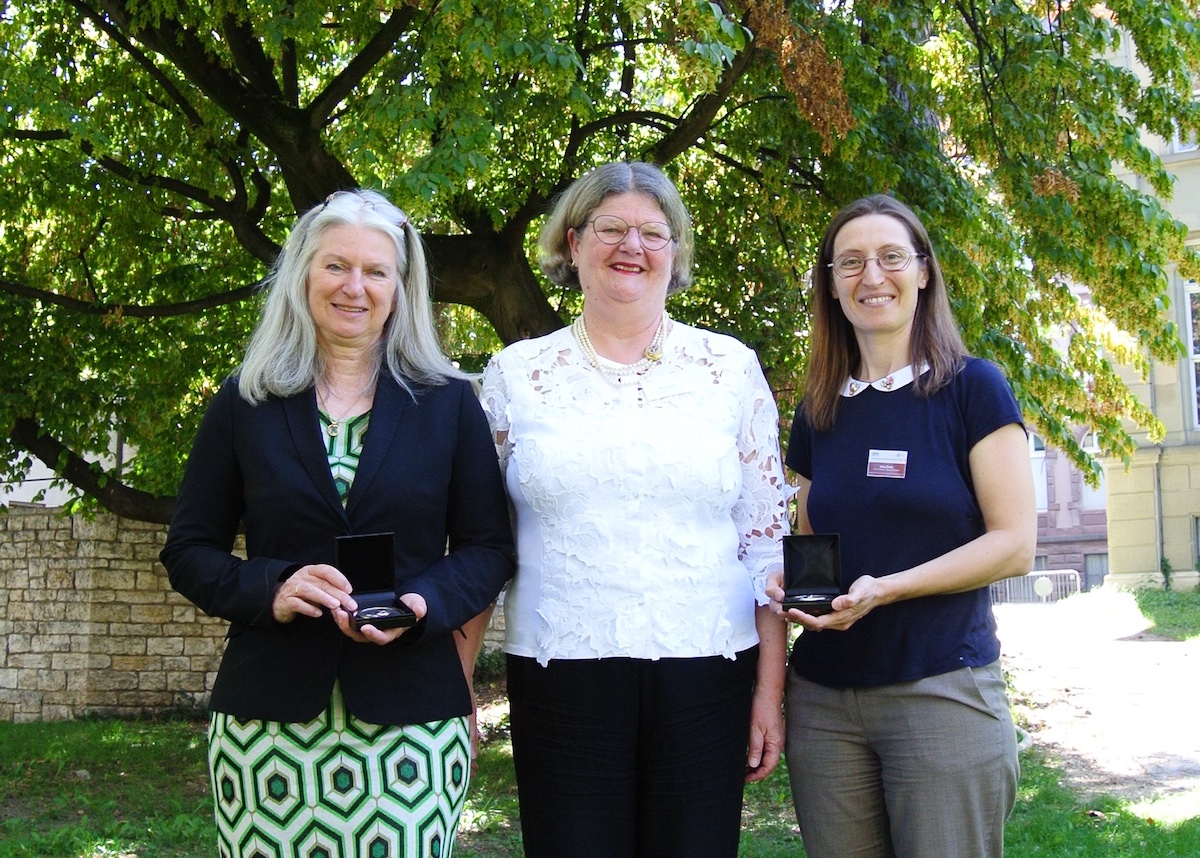
FLTR: Monika Ritsch-Marte, Petra Rudolf and Ilaria zardo - images: Gina Gunaratnam/EPS
Author: Gina Gunaratnam
The award ceremony of the joint meeting of the Swiss
Physical Society (SPS) and the Austrian Physical Society (ÖPG) took place in early September
at the University of Basel. Started with several awards of the SPS, the event continued with the prizes attributed
by the ÖPG and with the distinction of the
European Physical Society (EPS) dedicated to female physicists.
Prof.
Petra Rudolf, chair of the EPS Equal Opportunities Committee and former
president of the Society, handed over the EPS Emmy Noether Distinction
2022 to Prof. Monika Ritsch-Marte (full career) and to Prof. Ilaria Zardo (mid-career).
Monika
Ritsch-Marte, from the Institute of Biomedical Physics, Dept. of
Physiology & Medical Physics, the Medical University of Innsbruck,
Austria, was awarded " for exceptional contributions to
optical microscopy and manipulation methods and for the promotion of
women’s careers in physics. "
Ilaria Zardo, researcher at the Department of physics of the University of Basel, Switzerland, was awarded "for
her contributions in the methodology of characterizing nanoscale
materials and the consequent discovery of their new functional
properties. "
The ceremony was followed by an
interview of both EPS laureates by Prof. Rudolf and a group photo with
laureates of all the presented prizes in the beautiful botanical garden
of the Swiss university.
More info

Petra Rudolf presenting the EPS Emmy Noether Distinction to the SPS-ÖPG audience at the University of Basel

Group photo with all laureates of SPS, ÖPG and EPS prizes in the university's botanical garden
Tags:
distinction
Emmy Noether DIstinction
EPS EOC
EPS Equal Opportunities Committee
medical physics
nanomaterials
ÖPG
prize
SPS
University of Basel
Permalink
|
|
|
Posted By Administration,
Monday 19 June 2023
Updated: Tuesday 20 June 2023
|
Author: Ionut Topala
On the 22nd May 2023, the Faculty of Physics of the
Alexandru Ioan Cuza University of Iași (UAIC) has been named a “Historic
Site” by the European Physical Society (EPS). The Faculty of Physics in
Iasi is only the second Romanian institution to receive this honour,
after the Magurele Physics Campus in 2017.
A plaque
declaring the Faculty of Physics at the Alexandru Ioan Cuza University
of Iași (UAIC) as an EPS Historic Site was unveiled near the Dean’s
office by the EPS representative, Prof. Goran Djordjević, member of the
EPS HS committee. The messages from Prof. Luc Bergé, EPS President, Prof. Karl Grandin, EPS Historic Sites Committee president, and Prof.
Djordjević himself have been conveyed during the meeting and appreciated
by all participants. “I’m confident that this moment will act as a
model for all next generation of students in Physics here in Iași” said Prof. Gheorghe Popa, former Secretary of State for Research in Romania
and former Rector of Alexandru Ioan Cuza University of Iași.
The
participants were made up of former and actual decision-makers at
Faculty of Physics: Cristian Enachescu, Dean of the Faculty of Physics,
Ionut Topala, Deputy Dean and president of Romanian Physics Society Iasi
Branch, Alexandru Stancu, founder of the Museum of the Faculty, Violeta
Georgescu, former Deputy Dean and Dumitru Luca, former Dean and
Vice-Rector.
The
EPS Historic Site plaque is a symbol to recognise that the city of Iași
has been at the forefront of physics research in the region. As
mentioned on the plaque, some of the scientific landmarks which shaped
the world of physics are “the successful bone X-ray imaging and X-ray
experiments (1896-1906) and the first scientific paper describing the
effect of magnetic fields on chemical reactions (1894), both published
by Dragomir Hurmuzescu. Another landmark is the first correct
calculation of the theoretical magneton, the physical constant still
used to describe the magnetic moment of an electron by Stefan Procopiu
(1912-1913). In addition, since 1849, Teodor Stamati and later Stefan
Procopiu had developed significant observations on geomagnetism in
Romania. The Faculty of Physics has come a long way since then, becoming
a distinct department at UAIC in 1962”.
The
inauguration continued with the ceremony of awarding the title of
Doctor Honoris Causa of the Alexandru Ioan Cuza University of Iași to
Dr. Dumitru Dorin Prunariu, the first and only Romanian to go to perform
a scientific mission in space.
Visitors can now start their
journey with this EPS Historic Site plaque and then continue with the
Physics museum at Alexandru Ioan Cuza University of Iași, there where
pieces of instruments and laboratory equipment dating back from late
nineteenth and early twentieth century can be admired.
More information

The plaque for the EPS Historic Site, Faculty of Physics at Alexandru Ioan Cuza University of Iași, Romania - image credit: Ionut Topala

FLTR: Ionut Topala, Violeta Georgescu, Gheorghe Popa,Alexandru Stancu, Radu Tanasa,
Cristian Enachescu, Dumitru Prunariu,Dumitru Luca, Goran Djordjević

The main building of Alexandru Ioan Cuza University of Iași, Romania, hosting the Faculty of Physics

FLTR: Ionut Topala, Alexandru Stancu, Goran Djordjević, Cristian Enachescu
Tags:
(UAIC)
Alexandru Ioan Cuza
awards
distinction
EPS Historic Sites
Romania
Permalink
|
|
|
Posted By Administration,
Thursday 17 November 2022
Updated: Monday 17 October 2022
|
The European Physical Society launched the Emmy Noether
Distinction to recognize noteworthy women physicists having a strong
connection to Europe through their nationality or work.
Emmy
Noether, with her fundamental and revolutionary work in the areas of
abstract algebra and on the conservation laws in theoretical physics, is
an exceptional historical figure for all generations - past, present
and future - of physicists.
The laureates of the Emmy Noether
Distinction are chosen for their capacity to inspire the next generation
of scientists, and especially encourage women to pursue a career in
physics. Attribution criteria therefore focus on the candidate’s:
• research achievements
• endeavours in favour of gender equality and the empowerment of women in physics
• coordination of projects and management activity
• service to the scientific community and research administration
Nominators are encouraged to address these four points in their proposal.
Commencing
2022, the EPS Emmy Noether Distinction for Women in Physics is to be
awarded once a year, to two distinguished women physicists. Namely, the
Emmy Noether Distinction will be awarded to an early- and mid–career
laureate, as well as to a more advanced candidate, as a Distinction for
her full career.
The selection committee, appointed by the
EPS Equal Opportunities Committee, will consider nominations of women
physicists working in Europe for the 2022 Edition of the Emmy Noether Distinction as of the nomination deadline of 15th January 2023.
To make a nomination, please email the following information to the EPS Secretariat:
- A
cover letter, detailing (in no more than 3 paragraphs) the motivation
for awarding the EPS Emmy Noether Distinction to the nominee;
- The nominee’s name, institution and email
- The nominee’s CV
- The nominator’s name, institution, and email
- Optional: No more than 3 support letters
Download the distinction charter
Read more about the EPS Emmy Noether Distinction on the EPS website

Tags:
call
distinction
Emmy Noether
EPS Emmy Noether Distinction
EPS EOC
EPS Equal Opportunities Committee
women in physics
Permalink
|
|
|
Posted By Administration,
Thursday 20 October 2022
|
Author: David Lee
The EPS has two Early Career prizes to be awarded each year – one
each for achievements of a mainly theoretical or experimental nature.
Those eligible for these awards should have made a substantial
contribution to the development or reputation of physics in Europe.
"Early
Career" is defined as those individuals in the first 12 years of their
career in physics following their first degree or equivalent, with
allowance for any career breaks.
Terms and conditions can be found at: https://www.eps.org/page/distinction_prize_ec
Nominations should be made no later than 15th January 2023 to EPS Secretary General, David Lee.

Tags:
awards
call
distinction
EPS Early Career Prizes
prize
Permalink
|
|
|
Posted By Administration,
Thursday 15 September 2022
Updated: Thursday 15 September 2022
|
Author: Andrius Juodagalvis, Lithuanian Physical Society
On 2nd July 2022, Lithuanian enthusiasts of history of physics
gathered in Žeimelis, Lithuania, where the first EPS Historic Site in
the three Baltic states was inaugurated. Having reviewed contributions
of Theodor von Grotthuss (1785-1822), a scientist who lived in the
region in the beginning of the XIX century, the EPS Historic Sites
committee agreed that his laboratory in Gedučiai, near a small town of
Žeimelis, has influenced the development of physics to a comparable
extent as other scientific centres in Europe.
Theodor von
Grotthuss work gained world-wide recognition in 1806, after he published
an article on his theory of electrolysis of water, proposing to base
the electrolysis process interpretation on physical-chemical phenomena.
In his view, the electric field was polarizing molecules in a solution,
and continuous dissociation and recombination of molecules resulted in
the electrolysis effects visible only at the electrodes, where the chain
of pairs was broken. Since 1808 he worked in a laboratory at his
mother's estate in Gedučiai, which is currently a small village close to
Žeimelis in Pakruojis municipality district, Lithuania. Electrolysis
research was supplemented by various studies of interaction of light
with matter, which included phosphorescence and photochemical reactions.
Around 1817 he discovered regularities, that were later called the
Grotthuss-Draper first and second laws of photochemistry. Attempting to
create a unified concept of physical and chemical phenomena based on
charge and molecular constituents, in 1818-1819 Teodor von Grotthuss
concluded that interaction of opposite charges (positive and negative),
depending on conditions, manifests as light, heat, and electricity. The
same publication also proposed that water liquid contains molecules and
their elementary parts even in the absence of an external electric
field. The collective action of molecules that leads to the electric
conductivity of solutions due to proton jumping from one molecule to
another is still called the Grotthuss mechanism.
The EPS Historic
Site sign was placed in a central square of Žeimelis, where the statue
of Teodor von Grotthuss by a sculptor Kęstutis Balčiūnas was erected
earlier this year, in March. The recognition ceremony in Žeimelis was
opened by the chair of the EPS Historic Sites Committee, Karl Grandin.
His speech was translated into Lithuanian by a scientific secretary of
the Lithuanian Physical Society, Andrius Juodagalvis. The chairman of
the EPS selection committee for historic sites congratulated the
participants who witnessed inauguration of the first EPS historic site
in the three Baltic states. He also explained the meaning of distinction
as "a historic site," and highlighted Teodor von Grotthuss'
achievements that contributed towards his recognition by physicists, and
challenged chemists to weigh his influence, since his research topics
are on the borderline between physics and chemistry. Had the Nobel
Prizes been awarded when Grotthuss lived, he might have been awarded
one. Karl Grandin also gifted the local museum with a copy of the last
Theodor von Grotthuss' letter to his colleague in Sweden, Jacob
Berzelius. The president of the Lithuanian Academy of Sciences, Jūras
Banys cherished that a small town of Žeimelis joined the league of other
famous places in Europe, where the foundations of modern physics were
laid. Other speakers of the official ceremony were the president of the
Grotthuss' Foundation at the Lithuanian Academy of Sciences, Aivaras
Kareiva, the initiator of the EPS historic site application and a former
president of the Lithuanian Physical Society, Juozas Vidmantis Vaitkus,
the president of the Lithuanian Physics Teachers' Asociation, Rigonda
Skorulskienė, the dean of the Faculty of Physics at Vilnius University,
Juozas Šulskus, and the mayor of the Pakruojis municipality district
Saulius Margis. At the end of the ceremony, Karl Grandin declared the
EPS historic site in Žeimelis to be officially inaugurated. The entire
ceremony was started and finalized with live saxophone melodies.
The Lithuanian Physical Society
is grateful to the EPS Historic Site committee for recognition of
Theodor von Grotthuss research results, and the Pakruojis district
municipality for providing local support. Theodor von Grotthuss
scientific contributions are described following the EPS historic site
application written by J. V. Vaitkus and A. Kareiva, and an overview
article by B. Jaselskis et al, Bull. Hist. Chem. 32 (2007) 119-128.

Official participants of the EPS Historic Site inauguration in Žeimelis, Pakruojis municipality district, Lithuania.
Photo by A. Skorulskas
More info
Tags:
distinction
Electrolysis
EPS Historic Site
EPS Historic Sites
light
Lithuania
Lithuanian Physical Society
Theodor von Grotthuss
Permalink
|
|
|
Posted By Administration,
Thursday 15 September 2022
Updated: Thursday 15 September 2022
|
Author: Noortje de Graaf
We proudly announce the latest EPS Historic Site in the Netherlands: the
former Zeeman laboratory in Amsterdam. On 25th May, Pieter Zeeman's
birthday, the plaque on the building was unveiled by EPS Vice-President
Petra Rudolf. The Zeeman laboratory was opened in 1923 at Plantage
Muidergracht 4 in Amsterdam, it was specially equipped for experiments
that were carried out in the group of Nobel Prize Laureate Pieter
Zeeman. Pieter Zeeman was awarded the Nobel Prize in 1902 together with
Hendrik Lorentz. Today the building is inhabited, the laboratory has
been converted into several apartments. The unveiling was actually
planned in 2021 in the context of 100 years of Netherlands’ Physical
Society, but had to be postponed until 2022 due to Covid-19. The other
EPS Historic Sites in the Netherlands are Kamerlingh Onnes Laboratory in
Leiden, the NatLab in Eindhoven and Sonnenborgh in Utrecht.
Members of the Van der Waals-Zeeman laboratory of the University of Amsterdam made this short movie about the work of Pieter Zeeman and their own work.
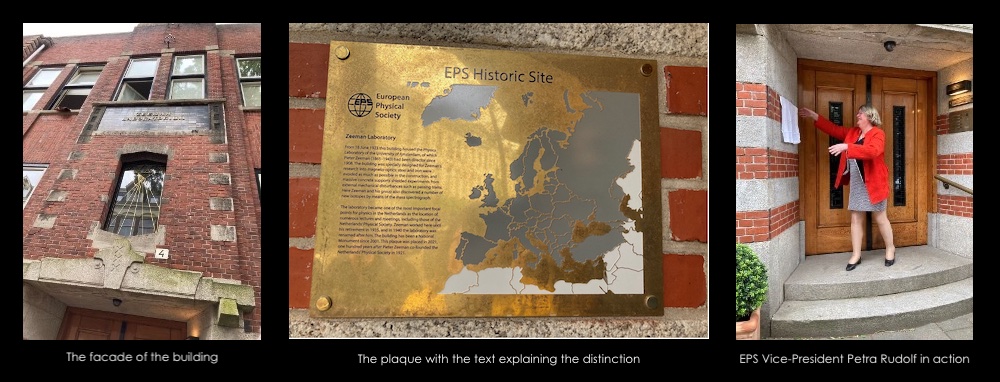
photos: NNV
More about the EPS Historic Sites programme
Tags:
distinction
EPS Historic Sites
Netherlands
NNV
Pieter Zeeman
Permalink
|
|
|
|